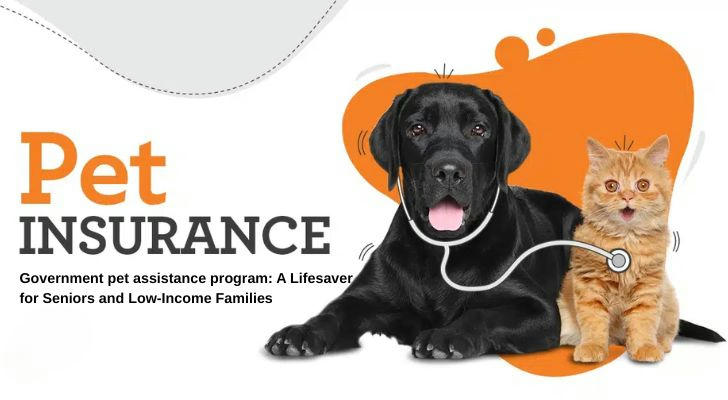Government Pet Assistance Program: What Seniors and Low-Income Families Need to Know
Veterinary bills too high? Living with inflation? Placing a burden on the elderly and low-income families? Now, the government's pet assistance program can relieve your stress, covering practical support such as vaccinations, sterilization, emergency care and food - so that pets no longer have to be a burden.

🐾Why pet insurance is important for low-income families and seniors
More than 60% of American households own a pet. For many seniors, pets are not only companions, but also play an irreplaceable role in alleviating loneliness, reducing anxiety levels, and encouraging daily activities. However, when sudden illnesses or accidents occur, pet bills often overwhelm families.
A regular veterinary visit may cost around $100, but if there is a chronic disease or surgery required, the cost may be thousands of dollars. Without pet insurance, low-income families or seniors will find it more difficult.
🧾 What do pet assistance programs usually cover?
Typically:
- Emergency care for accidents and illnesses
- Surgeries and hospitalization
- Diagnostic tests and prescription drugs
- Optional wellness care for vaccines, dental cleaning, and exams
What Are Government Pet Assistance Programs?
The government’s pet assistance program aims to reduce the burden of pet care, especially in terms of medical care, food, contraception and sterilization.
1. State-supported Pet Assistance Programs
Maryland SPCA Wellness Clinic: Discounted, full-service pet care for income-qualified residents
Los Angeles County Animal Care operates mobile clinics: Provide supportive or low-cost vaccinations, microchipping, and spay/neuter services.
Cook County (Illinois): Pet health vouchers issued through the nonprofit organization that low-income residents can use for vaccines, exams and care.
2. Pet Assistance Programs for Seniors & Low-Income Families
PAWS (Pets Are Wonderful Support): A nonprofit program that works with public health agencies to provide family support services such as pet food, medication, dog walking, and cleaning services to seniors and people with disabilities in cities such as San Francisco, Los Angeles, New York, and San Diego.
AARP Recommended Insurance Plans: For example, Fetch or ASPCA Pet Insurance, which usually provide preferential rates and simplified claims processing for people aged 65 and over.
Meals on Wheels Pet Program: In addition to delivering meals, Meals on Wheels in many areas also provides pet food and simple veterinary assistance to help seniors keep their pets healthy.
3. National Pet Assistance Programs
RedRover Relief: Provides grants for pet food assistance, emergency care (generally about $200) and domestic violence relief
Banfield Foundation HOPE Funds: Qualified low-income families can receive partial assistance for costs at Banfield Pet Hospital when their pet's life is threatened
For Pets' Sake Best Friends Program: Provides financial assistance for pet medical care for seniors or residents in need.
Budget-friendly Insurance Plans
✅ ASPCA Pet Health Insurance
- Customizable plans starting at $15/month
- Indemnity (70%-90%)
- Coverage for breed-specific conditions and behavioral therapies
- Claim processing time 3-15 business days
✅ Lemonade Pet Insurance
- No upper age limit
- As low as $10/month
- Indemnity (70%-90%) + flexible insurance options
- Fast claims processing 1-2 business days
💡4 Tips to Save Money
- Choose low-cost vaccination and neutering clinics: Many cities have mobile clinics operated by the government or non-profit to provide vaccination, neutering, and microchipping services
For example: Humane Society, SPCA, Banfield regularly hold low-cost vaccination days.
- Apply for assistance or use vouchers: Many pet assistance organizations can provide food and medical vouchers.
For example: RedRover Relief, The Pet Fund, Meals on Wheels Pet Program.
Specific discounts for seniors PetFirst's "Golden Paws" program waives age restrictions AARP members can enjoy a 10% discount at the ASPCA
Apply early: The younger and healthier your pet is, the cheaper the insurance cost, as low as $10 per month
How To Apply For Government Pet Assistance Programs
- 1️⃣Confirm eligibility: low-income families, seniors, etc.
- 2️⃣Find local programs: Senior pet programs can be provided through senior centers or Meals on Wheels partners.
- 3️⃣Prepare basic information: ID may be required
- 4️⃣Take your pet to the doctor or pick up assistance supplies on time
🙋 Real Story: A Lifesaver for My Beloved Pet
"I'm a teacher living in Boston, Massachusetts. Last year, my cat suddenly needed emergency surgery due to a severe infection. The vet bills quickly added up to over $4,500. Luckily, I had Embrace pet insurance, which covered most of the cost. I only ended up paying about $400 out of pocket. That insurance gave me peace of mind during a very stressful time." — Mark, Boston, MA
❤️ Conclusion
For low-income families and seniors, every dollar counts. Government pet assistance programs, whether subsidies, nonprofit partnerships, or local assistance programs, are proven strategies. It protects both the health of beloved pets and the finances of owners.
